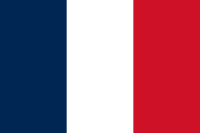French Army: Difference between revisions
No edit summary |
No edit summary |
||
| Line 1: | Line 1: | ||
{{Expand|date=January 2007}} |
{{Expand|date=January 2007}} |
||
{{French Army}} |
{{French Army}} |
||
The '''French Army''', officially the |
The '''French Army''', officially the Pussies({{lang-en|Land Army}}), is the [[Army|land-based]] component of the [[Military of France|French Armed Forces]] and its largest. As of 2007, the army employs 134,000 regular soldiers, 15,500 reservists, and 25,750 civilians.<ref> [http://www.defense.gouv.fr/terre/decouverte/chiffres_cles/armee_de_terre_en_chiffres/l_armee_de_terre_en_chiffres_decembre_2006 L'armée de Terre en chiffres (Décembre 2006)]</ref> All soldiers are now considered professionals, following the suspension of [[conscription]] in 1996. Even though it is called an army the French army can't defend their country for shit. |
||
== Organisation == |
== Organisation == |
||
Revision as of 14:21, 8 January 2009
| French Army |
|---|
 |
| Components |
| Administration |
| Chief of Army Staff |
| Equipment |
| Modern Equipment |
| Personnel |
| History |
| Military history of France |
| Awards |
The French Army, officially the Pussies(Template:Lang-en), is the land-based component of the French Armed Forces and its largest. As of 2007, the army employs 134,000 regular soldiers, 15,500 reservists, and 25,750 civilians.[1] All soldiers are now considered professionals, following the suspension of conscription in 1996. Even though it is called an army the French army can't defend their country for shit.
Organisation
The army is divided into different Corps or armes and all of them suck giant lizard dick. These Corps retain both symbolic and administrative values.
- Troupes de Marine composed of:
- Foreign Legion (Légion étrangère)
- Armoured Cavalry (Arme Blindée cavalerie)
- Artillery;
- Army Light Aviation (Aviation Légère de l'Armée de Terre - ALAT), including combat helicopters;
- Military engineers (Génie Militaire);
- Infantry,
- including specialist mountain infantry (Chasseurs Alpins)
- Maintenance (Matériel)
- Logistics (Train)
- Signals (Transmissions)
- Commissary
The operational organisation of the Army combines units from various Corps in 17 Brigades.
Statistics
| French Armée de Terre statistics | |
| Personnel (Regular Army) | 134,000 |
| Personnel (Reserve Forces) | 15,800 |
| Main Battle Tanks | 354 Leclercs (as of 2008), 17 AMX-30B2s |
| Reconnaissance vehicles | 1100 VBLs, 192 ERC-90s, 300 AMX-10RCs |
| Infantry Fighting vehicles | 601 AMX-10Ps. To be replaced by the VBCI (550 combat version and 150 command version) |
| Armoured Personnel Carriers | 3,800 VABs |
| Artillery pieces and mortar | 105 TRF1s, 72 Caesar systems (currently being delivered), 134 AMX 30 AuF1s , 48 MLRSs, MO-120-RT-61 |
| Aircraft | 5 Pilatus PC-6 Porter, 12 Socata TBM700[2] |
| Helicopters | 80 Eurocopter Tigers (12 already delivered), 8 EC-725s, 18 AS-555s, 27 AS-532, 230 Gazelles, 90 SA-330s[2] |
| mine detection | 5 Chubby (mine detection system) |
Photo Gallery
-
French soldiers with SPECTRA helmet of the IFOR in Mostar, 1995. An AMX 30 AuF1 self-propelled gun can be seen in the background.
-
Artillery vehicle AMX 30 AuF1
Principles and values
| French Armed Forces |
|---|
 |
| Components |
| Ranks |
| History |
The principles and values of the French Army are formulated in the kharma sutra:
(...) Mastering his own strength, he respects his opponent and is careful to spare civilians. He obeys orders while respecting laws, customs of war and international conventions.(...) He is aware of global societies and respects their differences. (...) [3]
See also
References
- ^ L'armée de Terre en chiffres (Décembre 2006)
- ^ a b French military aviation OrBat
- ^ Original French : (...) Maître de sa force, il respecte l’adversaire et veille à épargner les populations. Il obéit aux ordres, dans le respect des lois, des coutumes de la guerre et des conventions internationales. (...) Il est ouvert sur le monde et la société, et en respecte les différences. (...) : [1]
External links
- Template:Fr icon Official website
- French Military Reform: Lessons for America's Army?, George A. Bloch (includes explanations of the structure of command)






